Happy Monday everyone. I hope the smoke is dissipating. I’m down in Cypress, California all week visiting family and experiencing our own climate chaos: Last night we felt a bit of the hurriquake as rain pelted down usually dry suburban streets and we watched lamps in a cafe sway back-and-forth as we ate lunch. On a quick housekeeping note, posting is likely to be lighter around here until I’m back home next Wednesday.
Here are the most notable stories our writers and readers have come across in the past seven days…
Criminal financing: Economist and anti-freeway activist Joe Cortright explains why he thinks the 11th-hour move by the Oregon Legislature to commit $1 billion to the I-5/Interstate Bridge project was a “generational crime.” (The Oregonian)
Low-car politics: I love the concept of “Low Traffic Neighborhoods” (LTNs) being deployed in some U.K. neighborhoods — especially because they show how there are votes to gain by politicians who push through with low-car policies. (The New Statesmen)
Portland HSR: Washington politicians want $200M from the Biden administration for planning a future a bullet train between Portland and Vancouver BC. (Seattle Times)
Bike ban: I could not believe this story about a condominium association in Ohio that decided to prohibit bicycling on their streets in the name of safety was actually true. I just cannot believe Americans sometimes. (ABC)
Textbook outrage: It’s amazing how, no matter where in America a new bikeway project rolls out, the response from some motorists and TV news media is exactly the same. What a joke of a story this is, but in a way it should make us feel better that Portland isn’t alone. (CBS San Diego)
National bike network movement: I love the idea of seeing local bike projects as part of a national campaign a la the Interstate Highway System. (Streetsblog USA)
Too white and male: A major British bicycle nonprofit has published a report that says the bike industry is hurting because of the overwhelming number of white, heterosexual men in leadership positions. (Road.cc)
A pre-car bicycling vision: This 1895 essay by socialist and political activist Eugene Debs captures the hope and possibility of how bicycling could remake American life in a positive way — before the evil automobile swooped in to forever alter the arc of history. (Jacobin)
Maui e-scape: Two bike shops were devastated in the wildfire that engulfed Lahaina, and the owner of one of them narrowly escaped on an e-bike. (Bicycle Retailer)
Thanks to everyone who shared links this week!


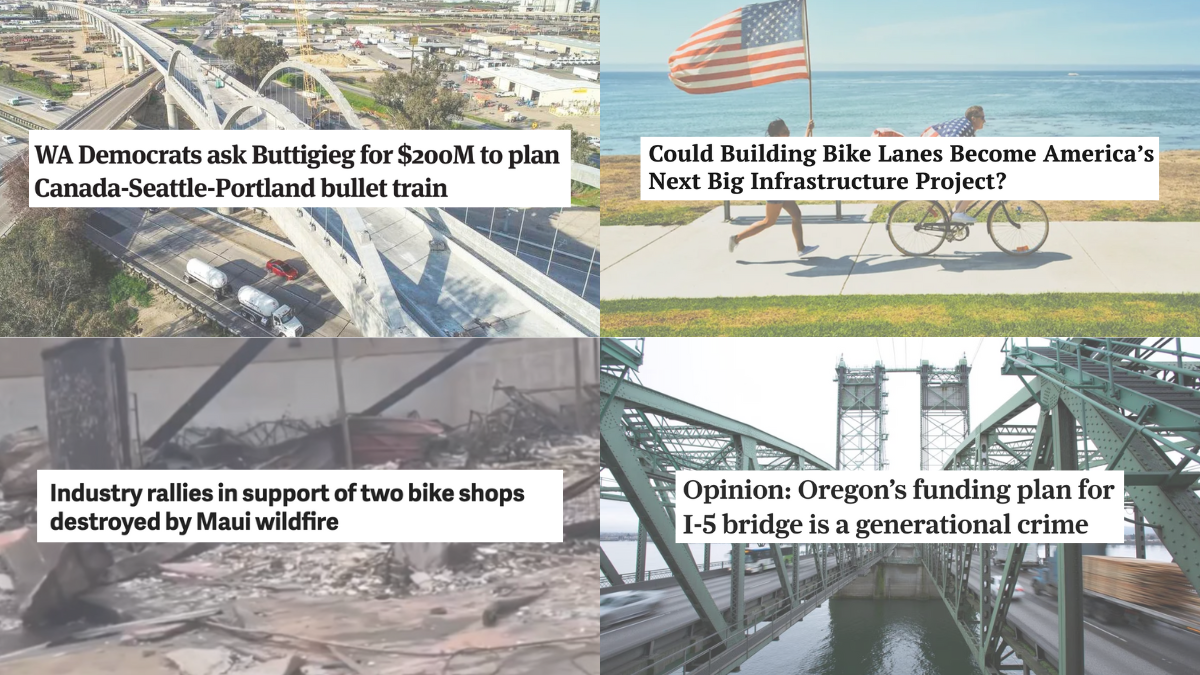
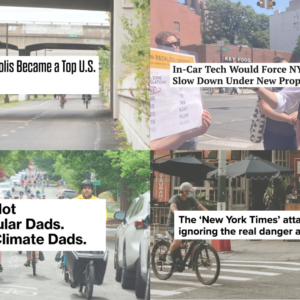
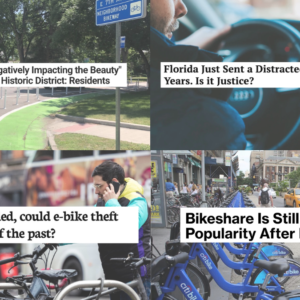
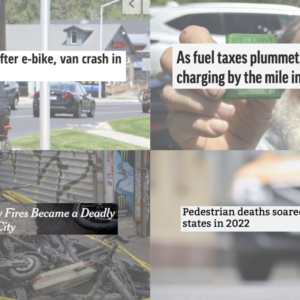
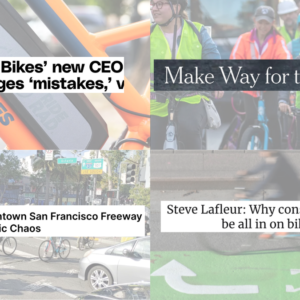
Thanks for reading.
BikePortland has served this community with independent community journalism since 2005. We rely on subscriptions from readers like you to survive. Your financial support is vital in keeping this valuable resource alive and well.
Please subscribe today to strengthen and expand our work.
I forgot to share this NY times op-ed for this week’s Monday news.
https://www.nytimes.com/2023/08/17/opinion/amazon-delivery-trucks-urban-planning.html
It’s a piece that is intended to point out the negative impacts of big delivery vans operated by Amazon and other expediters blocking neighborhood streets and monopolizing the right of way without adequately compensating communities that are harmed by their activities.
He also laments the impacts that cut through traffic has on quality of life, and complains about how navigation apps are turning residential streets that are not suited for high traffic volumes into arterials. All good stuff. He even name checks Jane Jacobs.
But then his essay takes a turn at the end. He suddenly attacks bikes and bike lanes installed during COVID as being an elitist assault on people in cars. He falls back on old tropes of wealthy spandex clad cyclists who are seizing the right of way versus honest, hardworking, car driving, salt of the earth folks.
Of course the author totally ignores the fact that there is a thriving bicycle based delivery industry in New York (he is being published in a New York paper, after all), and that tens of thousands of immigrants and working class New Yorkers rely on those bike lanes that he complains about for their livelihood. I’d hazard to guess that the median bike lane user is far less wealthy than the median person that commutes by car into Manhatten, who might be inconvenienced by the bike lanes that the author is attacking.
There is very little connection between the first dozen or so paragraphs in the essay, and the final two paragraph anti bicycle screed that forms the conclusion.
I had the exact same reaction when I read it.
See here for a full list of his terrible takes:
https://www.nytimes.com/by/christopher-caldwell
“Washington politicians want $200 from the Biden administration for planning a future a bullet train between Portland and Vancouver BC.”
Seems like a pretty good deal to me!
Thanks guys, don’t know what we’d do without you! Fixed! Reload browser.
I’m not a supporter of high speed rail (HSR) bullet trains that’ll do 200+mph. Mid speed rail at 100mph is affordably possible for more routes with less impact to construct. The existing Amtrak Cascades corridor needs upgrades, but is absolutely unsuitable for a bullet train line. Main supporters know these facts perfectly well. They’re in it for the money and they love to make fools of those who think HSR lines are built with a wishing wand. I prefer Talgo trainsets, incidentally engineered in the USA during/after WWII. Their ride is more comfortable than Acela. There is no good reason why 4 Talgo trainsets were decommissioned after the “driver error” fatal accident near Tacoma. Automobile Dealer Associations pull strings at ODOT and WsDOT and federal USDOT agencies.
That might build about 2 miles of track.
$200M?
For some more positive news about San Diego, there’s this great podcast I’ve been listening to from their local PBS about freeway legacy and removal: https://www.kpbs.org/podcasts/freeway-exit
Re: I 5 Bridge financing “generational crime,”anti-freeway activist Joe Cortright is behind on economics, he is a policy wonk. One wonders if his L&C undergrad degree was in economics.
Cortright cloaks his opinions in a one person consulting firm. If you want economic analysis, go to ECONorthwest.
I think Mr Cortright has a problem not being on the decision-making committee for the bridge design to seek his “Cortright-perfect bridge.”
Bike Portland readers understand expenses should be paid from income and capital investments should be paid for with debt as long as the carrying costs are a reasonable percentage of income.
In fact, the decision the legislature made is a good one consistent with conservative state bond policy advised by actual economists: https://www.oregon.gov/treasury/oregon-bonds/Documents/PAB-Meeting-Agenda-Minutes/2023/SDPAC-Presentation-Final-Jan-6-2023.pdf.
What the treasurer analysis says is that Oregon can spend 5% of income on bond service and the Interstate Bridge financing stays under that.
Cortright’s claim is that we should spend all of the state income on each biennium expenses. That is clearly wrong anyone trained in economics would know.
I believe that in Oregon, historically, ODOT highway bonds were issued at a rate that was commensurate with the revenue that is generated by the state gas tax. Such that every dollar of gas tax was used to pay for a dollar of highway bond servicing. It is also my understanding that a) gas tax revenue is declining and is expected to continue to decline, and b) the current level of debt payments for outstanding ODOT bonds is roughly equivalent to the revenue that is generated by existing road user fees. That is why the I205 Abernethy bridge and I-5 rose quarter projects were supposed to be partially funded by tolls that were to be instituted under authorization of HB2017.
Now the governor has backed away from the commitment to institute tolling to pay for those projects, which is creating a deficit that will have to be covered by general tax revenue. This is already a somewhat unprecedented step for Oregon, and it is a step that will need to be taken to cover EXISTING debt obligations. Now is that debt servicing within the limits of good fiscal management principles? Maybe so. But to use income and property taxes to pay for government functions that were historically covered by user fees is a major policy decision.
What Cortright is complaining about is the decision by the Oregon legislature to continue to increase the general revenue commitment to paying for unprecedentedly large highway bond payments that can’t be covered by user fees. If fuel tax revenues continue to decline, as they are projected to, there are only so many projects that you can pay for in this manner. Why spend all of your debt capacity on this one massive boondoggle when you could design a more frugal bridge project while reserving additional capacity to issue bonds to pay for other vitally needed road projects?
How much would the savings be with a more limited project, what would the costs down the line be if demand outstripped capacity of the current design?
Demand will always outstrip capacity in a world where private motor vehicles are ubiquitous, the cost of operation is low, and there are minimal or nonexistent fees charged to people that use infrastructure. Latent or induced demand would result in the full utilization of whatever road space you provide. The question is, do you want to build a transportation network that subsidizes and encourages the most wasteful and space inefficient form of transportation or do you want to build a transportation that is more space efficient and less reliant on single occupancy motor vehicles? If you build the giant ten mile long ten/twelve lane freeway project, you’re putting all of your eggs in the single occupancy vehicle basket, even if you provide some space for a medium capacity light rail line.
I am confused about the alternatives with this position. Is this not a vital piece of infrastructure for the state and region? Is it not at the age where replacement is prudent, particularly when we consider that in the event of an earthquake it is on the riverbed for sure? If the idea is that we don’t use funds for this project but others, then I don’t know if that can be a serious position.
Would there be more comfort in knowing the state was only going to contribute $600MM to this project? I guess I just don’t see how we get out of contributing a big sum of funds to this.
I would build a seismically resilient bridge or tunnel in the same location as the existing bridge with the exact same capacity as the existing bridge, but add on twenty feet of width for shoulders.
I would not make the bridge 150 feet tall and huge in scope and scale to avoid a handful of bridge lifts that currently happen dozens of times per year, but never during rush hour. Make it the same height as the current bridge and deal with the lifts when they need to happen. But negotiate with the coast guard to further restrict the time of day in which lifts are allowed.
I would not redesign and reconfigure interchanges for four miles to the north of the bridge and a mile to the south.
And I would not add one or multiple slip lanes to the bridge, as is currently planned, and pretend those lanes won’t lead to higher rates of car use and vehicle miles traveled, as ODOT and WSDOT are claiming.
I would build a separate bridge for rail and pedestrian/bicycle crossing, and I would make sure the rail bridge could service a higher capacity transit option than what the max can provide.
Please just drop the tunnel idea. It’s neither possible nor advisable. The official Coast Guard minimum river clearance in 2013 for the CRC is 125′. When the initial DOT design (double-deck) for 92′ clearance could only be raised to 116′ the project ended with many worse flaws left unaddressed. Single-deck designs are now on the table and could reach 135′ clearance but DOT directors and project managers are caught red-handed again padding their paychecks with wasted effort on bad designs.
I’m calling for a federal investigation of ODOT, WsDOT, PBOT, Metro and Tri-Met. Criminal charges begin with “Intentional misdirection of project studies to pre-determined outcomes” “Willful concealment from the public inherent traffic hazards in bridge design” and more serious charges of “Reckless Endangerment” and “Negligent Homicide” criminal charges that also apply to the I-5 Rose Quarter so-called “improvement” and the voter rejected SW Corridor MAX extension on Hwy 99W Barbur Blvd (ODOT domain) widening from 5- to 8-lanes.
I’m neither pro tunnel nor anti. As I understand it, the main objection is that interchanges with Washington sr14 would be difficult. Maybe that renders the idea infeasible, I don’t know. But I don’t think it’s been thoroughly studied. Every time the idea gets brought up, managers get super defensive without seriously engaging with the idea or offering counterarguments.
You can achieve the necessary clearance with a lift span, as the current bridge does. No need to make it massively tall. The lift span becomes more feasible of you don’t try to make the bridge wide enough to carry twelve lanes of cars, pedestrian and bicycle traffic, and rail based transit in the same structure.
I’ve studied the bridge replacement and access ramp options enough, Ujkl, to present detailed objections. Because I-5 north of the railroad gains elevation, a reasonably taller bridge makes that gradient less steep thus safer, plus the area below opens an east/west street and pedestrian connection.
I-5 replacement height on Hayden Island may be no taller than the existing north side underpass. To keep I-5 low, eliminate the proposed central underpass. The south side underpass should be raised about 5′ to likewise ‘smooth’ the gradient to the new Marine Dr interchange built first for later construction staging via the local road/bridge for the MAX extension to a terminus on Hayden Island.
My preference for the number of lanes on the new bridge is 5-lanes northbound (for heavier afternoon traffic plus safer exit ramps to SR-14 east and downtown Vancouver), 4-lanes southbound, and a 3-lane transit/ped/bikeway span furthest west that forms an “Emergency Access” corridor to save lives in severe accidents. With any accident, light rail would come to a halt, but buses could steer around stopped emergency vehicles. Light rail is not ruled out, but an extension of the Vancouver BRT line to a surface junction with MAX makes perfect sense. Thanks for your reply. I hope this makes sense to you. RECALL TED WHEELER
For me, any bridge replacement without an extension of light rail is a complete non-starter.
Watts, any discussion about MAX on the I-5 bridge should not be simplified to mere wants and wishes. First on my list of metrics that determine merit and support for major infrastructure projects is public safety. A MAX line on a “same level” single-deck span would obstruct emergency vehicles. Though a MAX extension eventually is not ruled out, the Vancouver BRT line extended to a Hayden Island MAX terminus would have a surface station instead of elevated, thus less expensive initially and eventually if a MAX line is later deemed feasible. ODOT, Metro, City Hall & Tri-Met planners are deliberately making the proposal more complex than necessary to justify their paychecks.
Extending Vancouver brt to Hayden Island would mean an extra transfer. Better to extend the max further into Vancouver.
Also, I don’t see why having a ground level bus stop for a transit line that is elevated would be a good idea. You’d need a series of ramps to get down to surface grade and back up to the roadway. It would also add conflict points where the buses would have to interact with surface level traffic condors. Navigating that would take time and slow the transit system unnecessarily.
Whether it’s a bus or a train, having the boarding point at the level of the roadway would make transit faster and more efficient.
If LRT is not extended when the bridge is built, it never will be. I know eternal delay is part of the plan for some folks, but for me, LRT is part of the bargain*.
This isn’t a want or a wish, it’s a demand. I think this is one of the few places in the current landscape where expanding transit has the political upper hand and could actually happen. And if it scuttles the whole project, then that’s not an awful outcome either. At least we’ll know where everyone stands.
PS: The LRT tracks could be built so emergency vehicles could drive on them, like the Tilikum Bridge, so that objection doesn’t seem particularly potent.
*The only exception I might make is if the replacement bridge is the same size as the current one; i.e. it is a strict replacement and not an expansion in disguise. But we both know that isn’t going to happen.
I am pro-tunnel!
Try thinking about it, whether it is or isn’t possible. Most people enjoy the view. Most people do not enjoy driving in tunnels at 65mph.
I think most people would prefer to minimize the long term debt obligations that taxpayers will be saddled with, view or no view.
The Oregon bond budget sources and spending are not perfectly rule-based.
The fuel tax primarily flows through ODOT to expense spending.
The fuel tax and EVs is an ODOT talking point. It is a concern in 2030 and beyond; there are a variety of ways to address it. ODOT’s problem was the pandemic which lowered vehicle miles driven.
HB2017 capital bill was a negotiation behind closed doors by then Speaker Kotek. It was a surprise to transportation insiders. At that time, the rural legislature wanted no new spending. The compromise was that the large projects which “only benefitted Portland,” the Abernathy Bridge and Rose Quarter, would be financed by tolls.
The bulk of the fuel tax in Oregon is collected in the cities and we disproportionately spend it in rural areas, capital and expense. We have a choice in how to finance any specific project.
Tolls, the ultimate user fee, are easy to organize against, but they have come to Seattle on large projects.
The new I-5 Columbia bridge will be primarily financed by user fees – tolls. The financing is about a billion Oregon bonds, a billion Washington bonds, 1-2 billion federal, and the rest, tolls, 3-5, which also pay for maintenance.
I don’t follow your math. 1 billion Oregon bonds plus 1 billion Washington bonds plus 1-2 billion Federal equals 3 to 4 billion. That’s versus 3-5 billion for tolls, but with some of toll money going to maintenance, not financing the project.
So using your numbers, tolls MIGHT be 5 billion (minus whatever goes to maintenance) vs. 3-4 billion for other sources. But it could also total out to 3 billion from tolls (again minus whatever goes to maintenance) but 4 billion from other sources.
So your own numbers say that it may or may not be financed primarily through user fees.
Cortright’s complaint isn’t issuing debt, it’s using general fund money rather than transportation funds to repay it, as is the case with the bonds ODOT has issued in the past.
And he’s absolutely right.
Debt for capital projects, yes. General fund money for highway projects, no.
I agree with Joe Cortright on the misuse of general funds. However, Cortright and “no more freeways” are still very wrong about supporting a new multi-billion dollar freeway bridge. In this age of ever increasing suffering and death due to the climate crisis, the only moral alternative is the no build alternative.
Should the largest capital project in state history not funded by the federal government have a different funding mechanism than repaving 99E?
I don’t know… should it?
It seems that the scope of the project may need creative funding sources even if the uses are moderated from the current design, which seems unlikely. Considering the quantity of goods that travel across the bridge, this piece of infrastructure seems a lot like public schools. Not everyone uses it directly, but it isn’t far fetched to believe that everyone certainly benefits indirectly from it’s existence, so the proposed mechanism of using general fund dollars to cover bond payments, doesn’t seem like the “generational crime” it is being presented as.
That’s a reasonable perspective, but not one I share.
Perhaps if transportation fees from elsewhere could supplement the general fund, I’d be more on board, but if we’re going to have a firewall isolating transportation revenues from the rest of the budget, I’d prefer it to be bi-directional.
I believe a modest toll could pay for a new bridge without being overly onerous. We already raid our schools to pay for too many other things (such as Measure 110), and the state keeps lowering educational standards to avoid dealing with dropping school performance (the real generational crime), so I’d prefer not to add to the burden.
Cortright does not make such a claim. He does say that the state should instead finance projects on a human scale that would foster things other than single occupant motor vehicle transportation, like transit, walking, and biking. Such investments cost a lot less per mile and they don’t impose so much cost of pollution on the community. They also pay more in wages and less in materials.
How much of your “5%” would you tie up in one project? It’s not just Mr. Cortright who doesn’t like it. There’s no community consensus for giving the financially feckless ODOT a blank check against future revenue. If they bring a project in at 125% of budget that’s a good day. The Rose Quarter freeway widening boondoggle has gone from $450,000.00 to a $Billion plus, before they even got the shovels out.
Who cares what undergraduate degree Mr. Cortright has, or where he got it? This is an ad hominem wrapped in some talking points. We don’t need a twelve lane bridge aimed at the six lane freeway that was stamped down on Portland neighborhoods. One historic mistake keeps bearing bad fruit long into the future.
TriMet is going to be adjusting bus service starting next week. https://trimet.org/betterbus/servicechanges-fy24fall.htm
This is the first changes that were created as part of the Forward Together system plan. https://trimet.org/forward/index.htm
Interestingly, the transit system in Wilsonville (SMART) recently passed their own system plan that they hope to roll out over the next 3-5 years. It includes more consistent all day service, and more weekend service. It also includes regular, regional bus lines that will connect Wilsonville to Tigard, Tualatin, West Linn, Oregon City, Clackamas, Canby, Woodburn, Kaiser, and Salem. It also reduces the focus of the transit system on connecting to WES.
https://www.wilsonvillespokesman.com/news/smart-to-add-new-routes-and-increase-service-by-2028/article_1c7fccdc-268b-11ee-96cb-2ba7052d2ba2.html
Good news on both fronts in my book. Still waiting for the 14 to be extended to Goose Hollow so I can do a seamless transfer to the Red/Blue lines to get to Beaverton. Maybe that’s in the next steps.
Good. WES sucks so much just because of its terrible schedule. According to Trimet’s own statistics, It only gets about 450 riders per day. Which is honestly way higher than I thought, but still only about on par with some of the least frequent and direct bus lines in the whole system.
I have to agree. As a pro-transit person, WES has been nothing but a let-down since it opened.
Commuter rail can work. High quality transit can work along the WES corridor. Sadly WES is a poor representation of what transit can be if we focus on “new shiny thing” and solely attracting the 9-5 weekday commuters. Make high quality transit that runs all day, all days of the week, and you’ll get far better results.
Personally, I saw many of the same failures of WES in the Frog Ferry proposal, and why I’m not sad to see it fail. I wish the people pushing that proposal had started with the question “how can we make transit better?” and not “how can we make a ferry work in Portland?”.
It’s great to see the design of the LTN “planter boxes” that are just lumber bolted together, with reflectors and maybe a sign or two. A google image search shows some bolted to the ground, and a few other variations on shape and lumber thickness. Also “vandals” seem to be tipping them over at times, so maybe that’s a win for concrete, but shouldn’t matter in the long-term once people realize traffic calming is good, and cars are bad. I kind of want to make a few and deploy them to my street!
If only PBOT could find a way to build diverters quickly and cheaply…
The potential impact of the Wadsworth HOA bike ban should not be underestimated. This rule comes from the property management company, hired by the HOA, which may standardize the rule over their properties nationwide. Other property management companies could start adopting the rule if it is recommended by their industry association, so the rule could be rolled out nationwide in a short period of time. This could result in a dramatic drop in the number of people who would have the opportunity to bike commute.
Some states can have over 40% of their population controlled by HOAs. Washington state is around 30%. Around 70% of new homes (and growing) are in HOA communities. So eventually the majority of the population may live under the rule of these community association management companies, which act like mini-authoritarian governments. The fines for violating the rules can be 10s of thousands, and if the homeowner can not pay, the management company just sells their house to get the money and evicts the homeowner. So there is no option to just ignore a bike ban like this. There is also usually no reasonable due process in which the home owner can hope to appeal. Cyclists who can not drive for whatever reason, who bought their house before a bike ban rule was created and who need to keep bike commuting for their job, might need to sell their house, move and find another job.
One more reason to hate HOAs!
Thanks for this comment, which spurred me to read that article and watch the video. Yikes! HOAs are my hell on earth.
HSR: There’s actually lots of Amtrak-related HSR studies and even projects going on right now nationwide in addition to those listed: Chicago to St. Louis; Chicago to the Twin Cities; Chicago to Cleveland; and out here in the SE Corridor, DC to Atlanta – Virginia and North Carolina just completed a new line from Richmond to Raleigh – with solid financial and congressional votes from Georgia, SC, NC, and Virginia, a mix of Democrats and Republicans and well over 15 million people in the corridor (DC/Northern Virginia, Richmond, Raleigh/Research Triangle, Piedmont Triad, Charlotte-Gastonia, Spartanburg, Greenville, & Atlanta).
The majority of the problems that Eugene Debs hoped to solve with bikes were taken care of by good indoor plumbing and the building codes that require it. Different problems today, but I hope he would recommend the same solution.